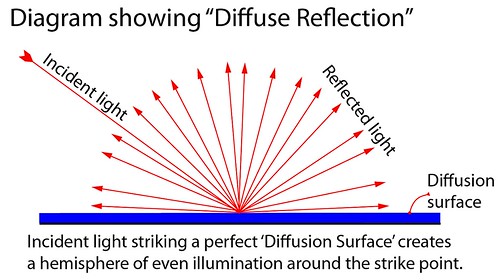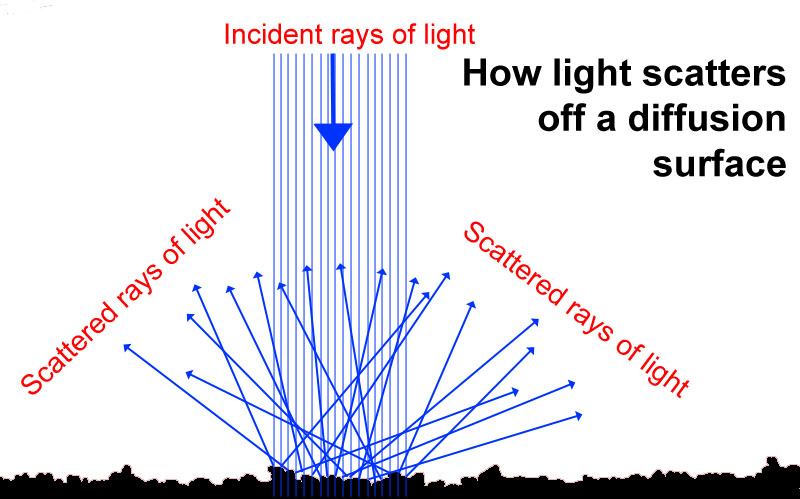![]()
Diffusion; diffusion reflection; (the process of…)
In photography, something that creates diffusion or diffused light is a device that evenly scatters the light from a light source. It is usually used to help soften light or can be directed so as to reduce harsh shadows.
The process that scatters light is what we call diffusion. The devices that we might use to create scattered light are called diffusers.
Diffusion reflection
This type of reflection occurs when an incident ray of light strikes a surface and the light is scattered. In a perfect diffusion reflection, all the light will form a hemisphere ![]() of illumination. This scatter occurs around the point the light strikes the diffusion surface. Your eye, fixed at one point, sees a reduced amount of light. The total light in the beam spreads over the whole illuminated space, thus reducing the amount hitting your eye.
of illumination. This scatter occurs around the point the light strikes the diffusion surface. Your eye, fixed at one point, sees a reduced amount of light. The total light in the beam spreads over the whole illuminated space, thus reducing the amount hitting your eye.
The diagram shows you the way light is scattered by a perfect diffusion surface. Although the diagram is only two dimensional (2D) the light scatter forms a hemisphere (3D) around a light strike-point. This model of diffusion is mainly of interest to physicists. It is not the best model of how a light beam reacts in reality.

• Diffuse Reflection •
In a diffusion reflection, you would see light reflected from a strike point in a hemisphere of illumination. Note: The diagram is only showing two dimensions – in reality the hemisphere is three dimensional around the light strike-point.
View large.
• Diffuse Reflection • By Netkonnexion on Flickr ![]()
Imperfection
Remember, the perfect diffusion reflection surface does not exist. Some of the light, in reality, may be absorbed by the surface. Some light coming off the surface you would see as diffused light. The scattered light radiates from around the strike point. A percentage of the light may be reflected in a reduced specular reflection. The amount of light reflected depends on the how well the surface reflects rather than diffuses.
Example:
- Low reflection, high scatter – white card: diffuser
- High reflection, low scatter – silver foil: reflector
Diffusion, the less than perfect reality
In the studio, an effective diffusion surface scatters light in all directions. So you would see light coming off it only as a proportion of the total light striking the surface. The diagram below is a more realistic version of how light scatters on a diffusion surface.

A partially absorbing, diffusing and reflecting surface might be white gloss paint. It is a surface that might absorb some of the light energy (eg. slightly warmed by the sun). It may also reflect some light, and diffuse some light. This would create a bright spot of reflecting light around the point the light strikes.
Examples when you shine a beam at different surfaces:
- An absorbing surface minimises reflection.
- Eg. a painted matt black surface like a black board;
- No reflection, you will see most light as scattered.
- A diffusion surface creates an illuminated spot;
- Eg. a white rough-surfac cardboard, like artists mount card;
- There is some point reflection, while most light scatters.
- A reflecting surface creates specular reflection;
- Eg. a mirror;
- Very little of your beam of light is scattered,
- You see a reflection as an image.
